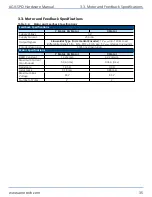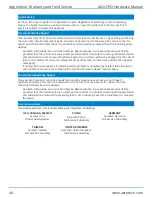
4.2.1. Focal Lens and Protective Glass
Optical surfaces that are contaminated with dirt and debris result in increased absorption of laser
radiation. Over time, this contamination can cause the optical surfaces to absorb enough heat to
cause permanent burn damage. There are several different kinds of optical surface contamination:
l
Airborne particles in the ambient atmosphere – dust, grease, etc.
l
Products from the laser process – vapors, back spatter, burned-in particles, etc.
l
Organic contamination – particles produced by talking, coughing, or sneezing near the optical sur-
faces.
Wherever possible, protect the exposed optics to avoid contamination. However, since
contamination cannot be completely avoided, you will have to periodically clean the optical system.
Regularly inspect and clean the optical surfaces to help prevent permanent damage.
WARNING
: Contamination from the laser process can cause irreversible damage to the
optical surfaces. To help minimize contamination, use a disposable protective glass
window and/or an exhaust or vacuum system.
Optical materials and coatings are relatively soft substances and incorrect cleaning techniques will
result in surface damage and drastically reduced component lifetime. The cleaning procedure for the
AGV-SPO is intended to help prolong the component lifetime.
IMPORTANT
: Wear clean, powder-free gloves when you handle optical components.
DANGER
: Make sure that the laser is set in the "off" position and secured against
accidental operation before you inspect or do maintenance to the focal lens.
WARNING
: If the focal lens does not have a protective glass window, take extra care
when you clean the focal lens.
Cleaning Procedure
1. Use compressed nitrogen or clean, dry, oil-less air to remove any loose particles from the surface.
2. Moisten an appropriate lint-free lens cleaning cloth with isopropyl alcohol.
3. Fold the cloth over such that one folded (straight) edge will serve as the leading edge during the
wiping motion.
4. Place the folded (straight) edge of the cloth onto one end of the optical surface. Applying very
minimal pressure, slowly move the cloth over the optical component to the opposite end. Never
bear down hard, scrub, or wipe in a circular motion when cleaning an optical surface.
5. Remove any liquid residue with a dry lint-free lens cleaning cloth or by blow it off in one direction
with compressed nitrogen or clean, dry, oil-less air.
6. Repeat this procedure, using a new lint-free lens cleaning cloth for each repetition, until the
surface is completely clean.
4.2.1. Focal Lens and Protective Glass
AGV-SPO Hardware Manual
40
www.aerotech.com
Содержание AGV-SPO Series
Страница 1: ...Revision 2 00 AGV SPO Single Pivot Point Galvo Scanner HARDWARE MANUAL...
Страница 6: ...This page intentionally left blank List of Tables AGV SPO Hardware Manual 6 www aerotech com...
Страница 12: ...This page intentionally left blank Laser Shutter AGV SPO Hardware Manual 12 www aerotech com...
Страница 14: ...This page intentionally left blank EU Declaration of Incorporation AGV SPO Hardware Manual 14 www aerotech com...
Страница 16: ...Figure 1 2 Standard AGV SPO Chapter 1 Overview AGV SPO Hardware Manual 16 www aerotech com...
Страница 30: ...This page intentionally left blank 2 6 Water Requirements AGV SPO Hardware Manual 30 www aerotech com...
Страница 38: ...This page intentionally left blank 3 5 Feedback Phasing AGV SPO Hardware Manual 38 www aerotech com...
Страница 46: ...This page intentionally left blank Appendix B Revision History AGV SPO Hardware Manual 46 www aerotech com...









































